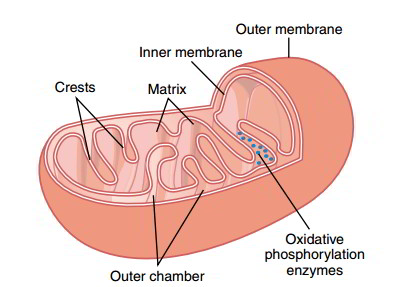The mitochondria are called the “powerhouses” of the cell. Without them, cells would not be able to draw out adequate energy from the nutrients, and basically all cellular functions would stop.
All cells in the body, with the exception of fully grown red blood cells, have from a hundred to a couple of thousand organelles called mitochondria. Mitochondrion (plural = mitochondria) is a membrane-bound cytoplasmic organelle worried about their main focus on production of energy.
Structure of Mitochondria
Mitochondria differ in shapes and size, however all have the exact same standard structure it is a rod-shaped or oval-shaped structure with a size of 0.5 to 1 g. It is covered by a bilayered membrane. The external membrane is smooth and confines the contents of mitochondrion. This membrane includes different enzymes such as acetyl-CoAsynthetase and glycerolphosphate acetyltransferase. In cristae are jointly called respiratory chain or electron transport system.
[irp]Enzymes and other proteins of respiratory chain
- Succinic dehydrogenase
- Dihydronicotinamide adenine dinucleotide (NADH) dehydrogenase
- Cytochrome oxidase
- Cytochrome C
- ATP synthase.
For this and other factors, lots of researchers think that mitochondria developed from different organisms, associated to bacteria, that got into the forefathers of animal cells and stayed in a state of symbiosis. This symbiosis may not constantly benefit the host; for instance, mitochondria produce superoxide radicals that can provoke an oxidative tension and some researchers think that build-ups of mutations in mitochondrial DNA might add to aging. Mutations in mitochondrial DNA happen at a rate a minimum of 10 times faster than in nuclear DNA (most likely due to the superoxide radicals), and there are more than 150 anomalies of mitochondrial DNA currently understood to add to various human diseases Nevertheless, genes in nuclear DNA code for 99% of mitochondrial proteins (mitochondrial DNA includes just 37 genes), therefore lots of mitochondrial diseases are produced by anomalies in nuclear DNA.
Neurons get energy entirely from aerobic cell respiration (a process that needs oxygen), which happens in mitochondria. Hence, mitochondrial fission (department) and transport over long ranges is especially essential in neurons, where axons can be approximately l meter in length. Mitochondria can likewise fuse together, which might assist to fix those harmed by “reactive oxygen types” produced within mitochondria.
[irp]Functions of Mitochondrion
Mitochondrion is called the ‘ power home’ or ‘ power plant’ of the cell since it produces the energy needed for cellular functions The energy is produced throughout the oxidation of digested food particles like proteins, carbohydrates and lipids by the oxidative enzymes in cristae. Throughout the oxidative process, water and co2 are produced with release of energy The launched energy is saved in mitochondria and utilized later on for synthesis of ATP.
The components of respiratory chain in mitochondrion are accountable for the synthesis of ATP by making use of the energy by oxidative phosphorylation. ATP molecules diffuse throughout the cell from mitochondrion. Whenever energy is required for cellular activity, the ATP molecules are broken down.
Cytochrome C and 2nd mitochondria-derived activator of caspases (SMAC)/ diablo produced in mitochondria are associated with apoptosis.
The inner membrane is folded in the form of shelf-like inward forecasts called cristae and it covers the inner matrixspace Cristae include lots of enzymes and other protein molecules which are associated with respiration and synthesis of adenosine triphosphate (ATP). Due to the fact that of these functions, the enzymes and other protein molecules
4. Other functions
Other functions of mitochondria consist of storage of calcium and cleansing of ammonia in liver.
[su_spoiler title=”References” style=”fancy” icon=”chevron”] http://europepmc.org/abstract/med/1962047 http://www.sciencedirect.com/science/article/pii/S0005272802002785 https://www.ncbi.nlm.nih.gov/pmc/articles/PMC2120516/pdf/jc1301157.pdf [/su_spoiler]

 (45 votes, average: 4.77 out of 5)
(45 votes, average: 4.77 out of 5)